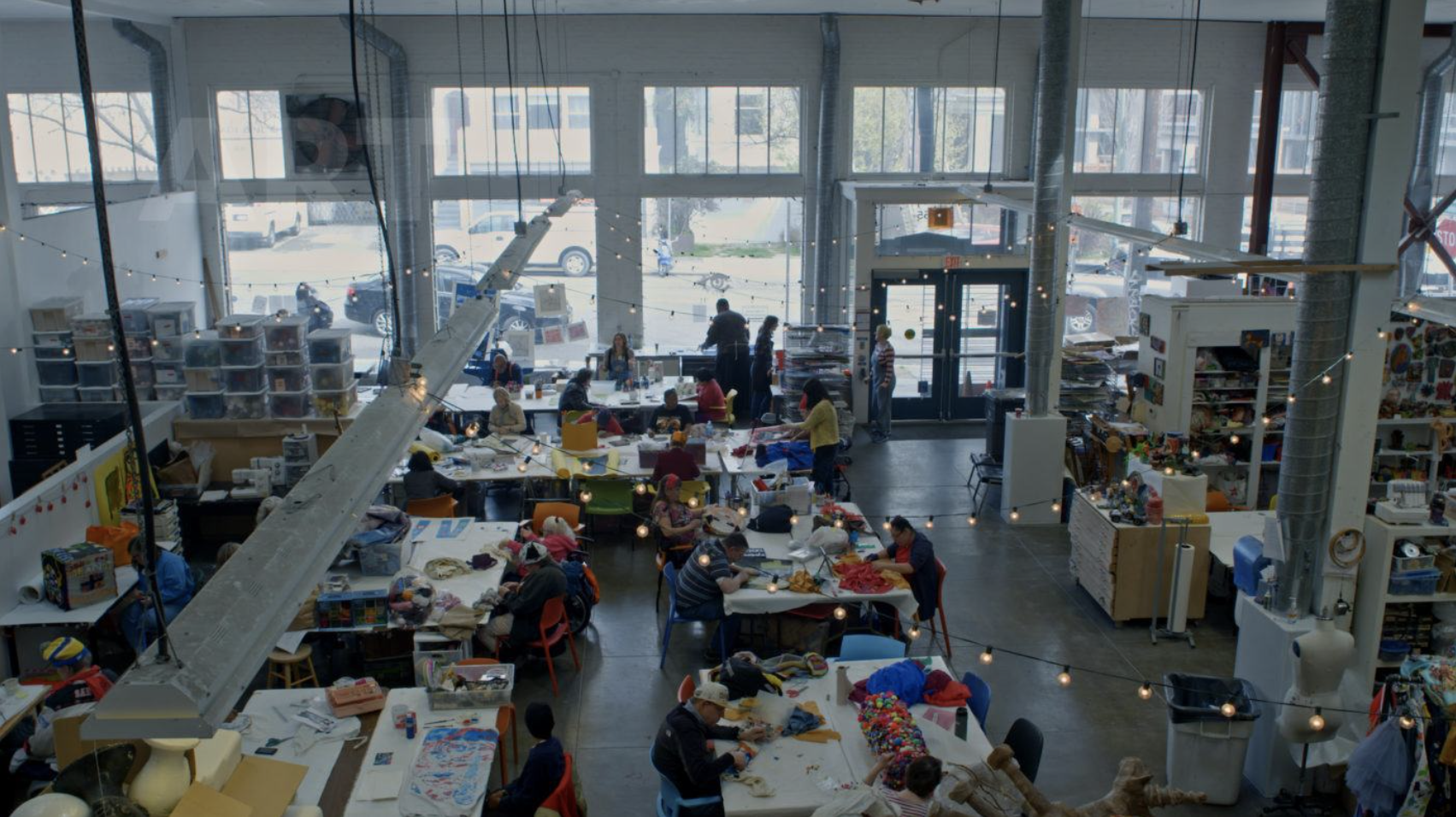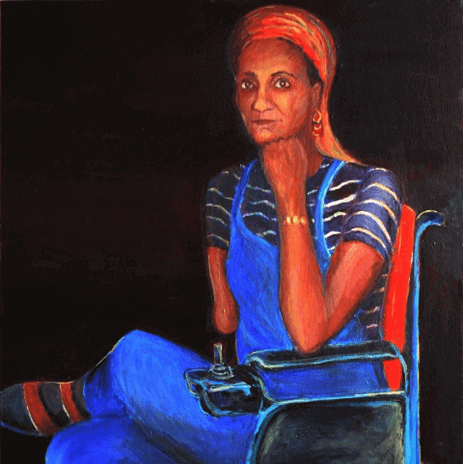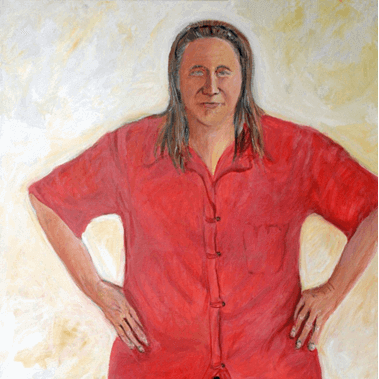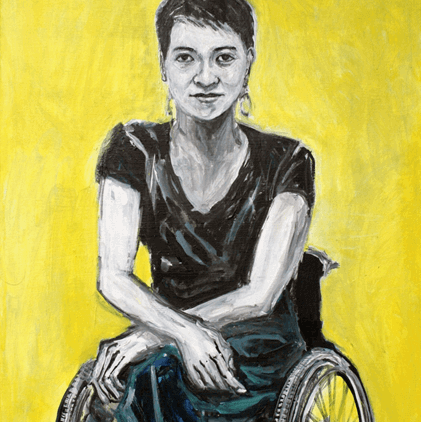Overview
In this lesson, students will be introduced to artworks by American artists who have a disability. Students will discuss how artists often make portraits to draw attention to a person or a group of people that may be underrepresented or overlooked, to tell their stories with dignity and respect. This lesson begins with an introduction to the unit that includes a discussion of disability and introduces several artists with disabilities working in a variety of media and themes. Students will explore the artwork through close looking, viewing of a video, and discussion.
Grade Level
6-8
Media
Theme/Big Idea
Artists can use collage techniques to create collagraph prints of someone they admire.
Essential Questions
- How can we honor someone through our artwork?
- How can we represent the unique qualities of an individual through full-body portraiture?
Materials and Tools
- Portraits of people with disabilities and artist statement by artist Bill Bruckner, Slides 2-4
- Myasia Dowdell. Beyonce, Slide 7
Note to Teachers
Lesson #1 is in two parts. Before students learn about artists with disabilities, it is important to ensure they fully understand what that phrase means. In Lesson #1 Part 1, students are introduced to the unit theme and engage in discussion about the work of several artists with disabilities. In Lesson #1 Part 2, students explore shapes of the face and create an expressive collage.
Objectives
Students will:
- Understand that artmaking is a fundamental human practice that should be accessible to all.
- Engage in close looking and discussion about works of art created by artists with disabilities.
Activities
Note: Teacher language is italicized.
Introduction (10 minutes)
Throughout this unit, you will be introduced to artworks by American artists who have a disability. What do you think it means to have a disability?
A disability is any condition of the body or mind that changes the way the person with the condition does certain activities and interacts with the world around them. There are many different types of disabilities, such as intellectual, physical, sensory, and mental illness.
How might having a disability affect an artist as they work? A disability is part of an artists’ culture and may influence the way that they work, the way that they see the world and the ways they see themselves in the world. For some artists, their disability may be a part of their identity that is a focus of their work. They may make work about having a disability or share the experience of having a disability.

Artists with a disability may want us to consider how we define what is beautiful. “Disability aesthetics” is a term used to describe artworks that challenge historical notions of beauty as associated with an ideal form or healthy body.

For other artists, their identity is that of an artist and their disability is not the focus of their work.

Teach: Creative Growth Art Center (20 minutes)
You have heard and read about the Civil Rights movement in the 1960’s. What do you know about it? What was the message of this movement? About 10 years later, a growing movement began in California known as the Disability Rights movement. What do you think that was about?
Many of the artists we will learn about in this unit have worked with art studios for artists with disabilities, such as Creative Growth in Oakland, California. Creative Growth Art Center is a nonprofit organization serving artists with physical and cognitive disabilities. It was founded 1974 at the height of the Disability Rights movement. Let’s watch the following video to learn more about Creative Growth and the artists who work there. While you watch, pay attention to the different kinds of art making you see the artists engaging in. We will talk about the message of this video afterwards.

- What are some of the different materials and processes you saw the artists use?
- Which artist’s work stood out to you? What did you find interesting about their work?
- In the video, the director said that a place like Creative Growth shouldn’t need to exist. What do you think he meant by this?
Students should understand that artmaking is a fundamental human practice that should be accessible to all.
In this unit, we are going to create portraits of someone we admire and would like to honor. Sometimes artists make portraits to draw attention to a person, or a group of people that may be underrepresented or overlooked, in order to tell their stories with dignity and respect.
Group or Independent Work: Close Looking (25 minutes)
Let’s look closely at this series of portraits by the artist Bill Bruckner.
Note to Teachers: Before teaching with a work of art, spend some time looking closely on your own. Familiarizing yourself with the artwork will prepare you to guide the close looking activity.
If your students are new to looking at art together, you can introduce the activity to students in the following way:
Today we are going to spend some time looking at and discussing a work of art together. When we look at art, there are no right or wrong answers. I’m going to ask you to look closely, share your ideas about what you see, and listen respectfully to others’ ideas. Everyone’s ideas are important. We all see things differently and when we look at art, we can learn to see through each other’s eyes.





After students have had time to view these works individually or in small groups, have a group discussion based on the questions below.
- Look closely at these portraits. What do you notice?
- How are these works different from other portraits that you’ve seen?
- The artist, Bill Bruckner, asked the people he painted to look directly ahead so that it looks like they are making eye contact with us when we look at them. How do you think the paintings would feel different if the people were looking away from us?
- What do you think the artist wants us to know about himself and his friends in these portraits?
Bill Bruckner shared the following statement about his series of portraits of his friends with disabilities. Note to teachers: you may wish to make copies of this quotation for students to use as a prompt for discussion.
“As a person with a lifelong visible disability, I have been acutely aware of the patronizing, objectifying ways in which we are often depicted in the arts. Over the past 25 years I have been creating a series of portraits of my friends who have disabilities. Because I believe that our lives are neither pitiable nor inspiring, my intent has been to convey images of our ordinary dignity, humanity and self-respect. I hope you will feel that the people in these portraits are gazing at you with as much curiosity and interest as you may have about them.”
What do you see in the portraits that connect to this quote?
Reflection/Wrap up:
In our next lesson, to begin our unit on portraiture, we will explore cutting and tearing shapes to represent facial features that show different expressions.
Vocabulary
Portrait, disability, disability aesthetics, Disability Rights Movement
Resources
Bill Bruckner’s Portraits of People with Disabilities
Disability Rights and Education History
NYC Blueprint Strands Addressed
#2 Developing Visual Arts Literacy
#3 Making Connections through Visual Arts
#4 Community and Cultural Resources
#5 Careers and Lifelong Learning
